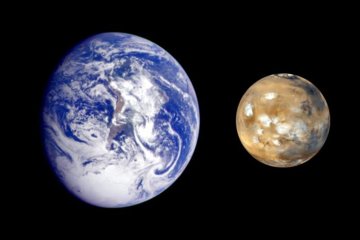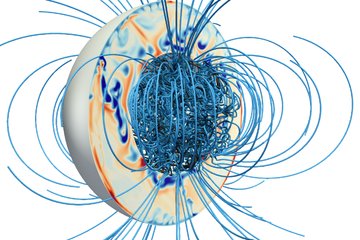
SEISmometer for the Mars-Mission Insight
The Seismic Experiment for Interior Structure (SEIS) is part of the scientific payload of NASA’s InSight mission. Landing on Mars in 2018, SEIS will be the first European seismometer on another planet. The instrument is capable of recording ground motions of a fraction of 0.001 mm over a broad frequency range between 0.001 Hz and 50 Hz. In this way, it can capture signals from marsquakes, meteorite impacts, local events like dustdevils or landslides, and even the tiny tidal deformation of Mars induced by its moon Phobos. Recording and analyses of seismic waves that have been transmitted through the interior of Mars will provide important insights into the planet’s interior structure. SEIS is expected to run continuously for at least one Martian year (687 days) and collect sufficient data to address a number of scientific questions.
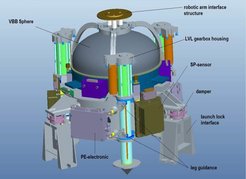
The SEIS instrument is developed jointly by Institute de Physique du Globe de Paris (IPGP), Centre National d’Etudes Spatiales (CNES), Imperial College London, Oxford University, ETH Zürich, NASA‘s Jet Propulsion Laboratory (JPL), and Max Planck Institute for Solar Systems Research (MPS). MPS contributes the leveling system for SEIS, which will also provide the necessary ground coupling, as well as the corresponding drive electronics.
Scientifc Goals
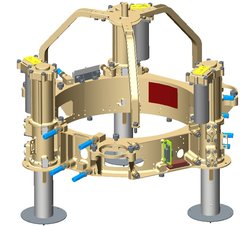
InSight targets the interior structure of Mars. Together with the existing knowledge about planet Earth, the new information on Mars will also allow more general conclusions on the formation and evolution of terrestrial planets. The central instrument to investigate Mars‘ interior is SEIS. Specifically, the following questions will be addressed:
- Crustal thickness and internal structure: Gravity measurements from space show a clear contrast in crustal thickness between the northern and southern hemispheres of Mars, which broadly agrees with the dichotomy between the northern lowland plains and the southern highlands. An absolute determination of crustal thickness, which is needed to calibrate the gravity data, is as yet missing, though. Based on different modes of mantle convection (e.g. including or excluding plate tectonics), models for the thermal evolution of Mars lead to distinctly different present-day crustal thicknesses. An actual measurement of the crustal thickness can thus help to better constrain Mars‘ evolution and dynamics.
- Mantle structure and composition: Knowledge on mantle composition can be used to constrain convection models for the Martian mantle. This will lead to a better understanding of, for example, the formation of volcanism in Tharsis, the location of Olympus Mons.
- Core size, composition and physical state: Is there a fluid core, like on Earth? The physical state of the core is especially important in models for Mars‘ magnetic field. The magnetic field of Earth is generated through dynamo processes in the fluid outer core of the planet. In contrast to Earth, Mars currently does not possess a magnetic field. However, measurements show that old crustal rocks on Mars were formed under the influence of a planetary magnetic field, indicating that such a field existed in an earlier phase of the planet. How and why the magnetic field vanished is not understood, yet, and knowledge on the state of the Martian core would be very useful to answer this question.
- Current seismic activity of Mars: Until now, models for the frequency of marsquake occurrence are based on fault zones mapped in aerial photography and assumptions about their age and activity. In contrast, the seismic detection of marsquakes will directly provide information on both location and intensity of present-day tectonic and volcanic activity of the planet.
- Meteorite flux: The frequency of meteorite impacts is relevant not only in terms of hazard for possible future manned missions to Mars. The density of meteorite craters imaged in aerial photography is also used to date the age of planetary surfaces. So far, values extrapolated from the Moon are used for Mars, but the conversion of these values to other planets involves a significant uncertainty. This uncertainty will be markedly reduced by actually measuring the impact rate on Mars, thus leading to a better understanding of the temporal evolution of the planet.
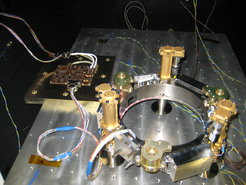
The Instrument
SEIS consists of a three-component very broad-band seismometer (VBB) in symmetrical triaxial configuration and a short-period three-component micro-sensor (SP). This instrumentation can detect motion over a broad frequency range in all three spatial dimensions (vertical and two orthogonal horizontal directions). Both types of sensors are based on the principle of an inertial mass in suspension, which is excited into vibration by external forces. The suspension of the test mass is adapted to the lower gravity of Mars, and the sensors are built to withstand the extreme temperature and pressure conditions on the planet. SEIS will be placed on the surface of Mars by the lander’s robotic arm. Recorded data are proportional to ground velocity. The instrument is designed to run continuously during the whole mission.
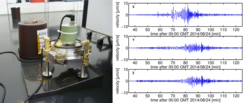
The highly sensitive VBB needs an exact leveling in order to operate, whereas no sensible seismic signals can be recorded without good and stable coupling to the ground. Both of these issues are addressed by the leveling system, which is developed at MPS. It can compensate for ground roughness up to a 15 degree slope by independently extracting or retracting the three legs by up to 6 cm. The alignment of the system is monitored by two sets of tilt meters with different sensitivities and ranges. The leveling system’s feet are adjusted for local surface conditions at the landing site. A cone-shaped tip will penetrate into the sand and lend stability to the installation, whereas a disk at the upper limit of the foot will prevent uncontrolled further sinking and provide good coupling to the ground.








